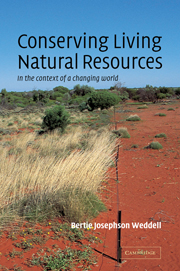Book contents
- Frontmatter
- Contents
- Preface
- Introduction: Balance and flux
- Methodology: Getting the information we need to manage living natural resources
- Part I Management to maximize production of featured species – a utilitarian approach to conservation
- Part II Protection and restoration of populations and habitats – a preservationist approach to conservation
- 7 Historical context – the rise of environmental concerns after World War II
- 8 Central concepts – the causes of extinction
- 9 Techniques – protecting and restoring species
- 10 Techniques – protecting and restoring ecosystems
- Part III Management to maintain processes and structures – a sustainable-ecosystem approach to conservation
- Postscript
- Appendix: Scientific names of organisms mentioned in the text
- Index
9 - Techniques – protecting and restoring species
Published online by Cambridge University Press: 05 June 2012
- Frontmatter
- Contents
- Preface
- Introduction: Balance and flux
- Methodology: Getting the information we need to manage living natural resources
- Part I Management to maximize production of featured species – a utilitarian approach to conservation
- Part II Protection and restoration of populations and habitats – a preservationist approach to conservation
- 7 Historical context – the rise of environmental concerns after World War II
- 8 Central concepts – the causes of extinction
- 9 Techniques – protecting and restoring species
- 10 Techniques – protecting and restoring ecosystems
- Part III Management to maintain processes and structures – a sustainable-ecosystem approach to conservation
- Postscript
- Appendix: Scientific names of organisms mentioned in the text
- Index
Summary
We have seen that concern about loss of biodiversity spearheaded an interest in resource management directed at protecting species and habitats. In this chapter we will examine measures that are being taken to slow the earth's extinction rate.
Overview of options: Strategies for preventing extinctions
Only two basic approaches are available if we want to prevent extinctions - reducing or reversing the factors that trigger species' declines and assisting with recovery. Stemming the tide of species loss involves identifying the proximate causes of species declines and addressing them.
The most direct way to decrease mortality caused by people is to regulate exploitation. A decrease in harvest may also lead to an increase in reproductive rate, if young are taken or if exploitation inhibits reproduction. Of course, limiting harvest will only help populations in trouble if other factors causing mortality or limiting reproduction are also addressed.
This chapter describes direct methods that attempt to protect and restore populations in trouble. In addition, managers often attempt to decrease mortality and increase reproduction indirectly by protecting or restoring habitats. This is covered in Chapter 10.
Decreasing losses
Regulating exploitation
International agreements
In North America the first international agreement to regulate traffic in wildlife products was the Migratory Bird Treaty between the United States and Canada, which was first signed in 1916 (see Chapter 1). examples of international agreements to regulate exploitation of wild organisms are described below.
- Type
- Chapter
- Information
- Conserving Living Natural ResourcesIn the Context of a Changing World, pp. 225 - 245Publisher: Cambridge University PressPrint publication year: 2002



